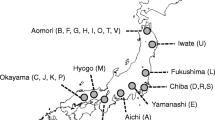Abstract
Repetitive sequence-derived PCR using the BOX-A1R primer was used to generate genomic fingerprints of Clavibacter michiganensis subspecies sepedonicus, the causal agent of bacterial ring rot disease of potato. A total of 35 C. michiganensis subsp. sepedonicus strains were selected for study in order to represent the widest possible historical, morphological and geographical diversity of the organism. Comparison was made with genomic fingerprints of C. michiganensis subsp. michiganensis, C. michiganensis subsp. insidiosus, C. michiganensis subsp. tessellarius, C. michiganensis subsp. nebraskensis as well as other related Gram positive plant pathogens. The resultant genomic fingerprints and subsequent cluster analysis show C. michiganensis subsp. sepedonicus to form a remarkably homogeneous group with approximately 84% similarity between all of the strains tested. There was no evidence to suggest that fingerprints varied with historic, morphological or geographic diversity. In addition, C. michiganensis subsp. sepedonicus isolated from asymptomatic sugar beet had the same fingerprint as those which were isolated as potato pathogens. This group was easily distinguished from the clusters formed by the other subspecies of C. michiganensis and Gram positive plant pathogens. The potential for this technique to be used as a relatively rapid method to replace the time consuming and sometimes inconclusive eggplant bioassay test is discussed.
Similar content being viewed by others
References
Anonymous (1993) Council Directive 93/85/EEC of 4 October 1993 on the control of potato ring rot. Official Journal of the European Communities L 259: 1-25
Anonymous GelCompar Reference Manual Version 4.1 Applied Maths. Kortrijk, Belgium
Bishop AL and Slack SA (1987) Effect of inoculum dose and preparation, strain variation, and plant growth conditions on the eggplant assay for bacterial ring rot. American Potato Journal 64: 239-246
Buchanan RE and Gibbons NE (eds) (1974) Bergeys Manual of Determinative Bacteriology. Williams and Wilkins Company, Baltimore
Bugbee WN, Gudmestad NC, Secor GA and Nolte P (1987) Sugar beet as a symptomless host for Corynebacterium sepedonicum. Phytopathology 77: 765-770
Davis MJ, Gillaspie AG, Vidaver AK and Harris RW (1985) Clavibacter: A new genus containing some phytopathogenic bacteria, including Clavibacter xyli subsp. xyli sp. nov. and Clavibacter xyli subsp. cynodontis subsp. nov., pathogens that cause Ratoon Stunting disease of sugarcane and Bermudagrass Stunting disease. International Journal of Systematic Bacteriology 34: 107-117
De la Cruz AR, Wiese MV and Schaad NW (1992) A semi selective medium for isolation of Clavibacter michiganensis subsp. sepedonicus from potato tissues. Plant Disease 76: 830-834
Henningson PJ and Gudmestad NC (1991) Fatty acid analysis of phytopathogenic coryneform bacteria. Journal of General Microbiology 137: 427-440
Janse JD and van Vaerenbergh J (1987) Interpretation of the EC method for the detection of latent Corynebacterium sepedonicum infections in potato. EPPO Bulletin 17: 1-10
Jansing H and Rudolph K (1998) Physiological capabilities of Clavibacter michiganensis subsp. sepedonicus and development of a semi-selective medium. Journal of Plant Disease and Protection 105: 590-601
Lelliott RA and Stead DE (1987) Methods for the diagnosis of bacterial diseases of plants. In: Methods in Plant Pathology, Vol 2 (pp 162-163) Blackwell Scientific Publications, London
Louws FJ, Fulbright DW, Taylor-Stephens C and de Bruijn FJ (1995) Differentiation of genomic structure by Rep-PCR fingerprinting to rapidly classify Xanthomonas campestris pv. vesicatoria Phytopathology 85: 528-536
Louws FJ, Bell J, Medina-Mora CM, Smart CD, Opgenorth D, Ishimaru CA, Hausbeck MK, de Bruijn FJ and Fulbright DW (1998) Rep-PCR-mediated genomic fingerprinting: A rapid and effective method to identify Clavibacter michiganensis. Phytopathology 88: 862-868
Louws FJ, Rademaker JLW and de Bruijn FJ (1999) The three Ds of PCR-based genomic analysis of phytobacteria: Diversity, detection and disease diagnosis. Annual Review of Phytopathology 37: 81-125
Metzler MC, Zhang YP and Chen TA (1992) Transformation of the Gram positive bacterium Clavibacter xyli subsp. cynodontis by electroporation with plasmids from the IcP incompatibility group. Journal of Bacteriology 174: 4500-4503
Mills D, Russell BW and Williams Hanus J (1997) Specific detection of Clavibacter michiganensis subsp. sepedonicus by amplification of three uniqueDNAsequences isolated by southern hybridisation. Phytopathology 87: 853-861
Murry MA, Zang D, Schneider M and de Bruijn FJ (1995) Use of repetitive sequences and the polymerase chain reaction (Rep-PCR) to fingerprint the genomes of Frankia isolates. Symbiosis 19: 223-240
Nelson GA (1980) Long-term survival of Corynebacterium sepedonicum on contaminated surfaces and in infected potato stems. American Potato Journal 57: 595-600
SchneiderMand de Bruijn FJ (1996) Rep-PCR mediated genomic fingerprinting of Rhizobia and computer-assisted phylogenetic pattern analysis. World Journal of Microbiology and Biotechnology 12: 163-174
Stead DE (1993) Potato Ring Rot control through detection and certification. BCPC Monograph No. 54: Plant Health and the European Single Market 135-144
Stead DE, Hennessy J and Wilson J (1998) Modern methods for identifying bacteria. Plant Cell, Tissue and Organ Culture 52: 17-25
Versalovic J, Schneider M, de Bruijn FJ and Lupski JR (1994) Genomic fingerprinting of bacteria using repetitive sequence-based polymerase chain reaction. Methods in Molecular and Cell Biology 5: 25-40
Welsh J and McClelland M (1990) Fingerprinting genomes using PCR with arbitrary primers. Nucleic Acids Research 19: 303-306
Author information
Authors and Affiliations
Rights and permissions
About this article
Cite this article
Smith, N.C., Hennessy, J. & Stead, D.E. Repetitive Sequence-derived PCR Profiling Using the BOX-A1R Primer for Rapid Identification of the Plant Pathogen Clavibacter Michiganensis Subspecies Sepedonicus. European Journal of Plant Pathology 107, 739–748 (2001). https://doi.org/10.1023/A:1011955811847
Issue Date:
DOI: https://doi.org/10.1023/A:1011955811847




